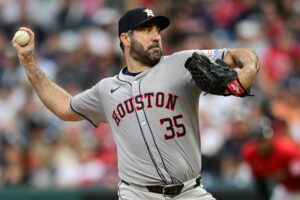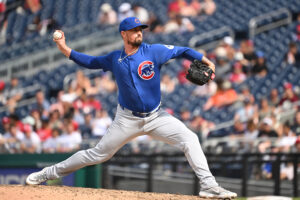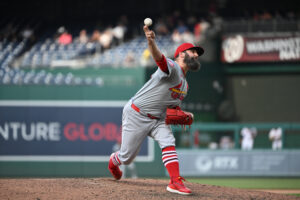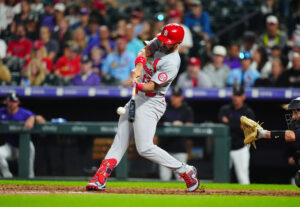The New York Mets finished 2016 with a record of 87-75 and lost in the Wild Card round of the playoffs. The 2016 season saw the Mets make their ninth playoff appearance in franchise history. The team received valuable contributions from various players over the course of the season. Last Word On Baseball writer John Jackson will count down the top ten most valuable Mets on a weekly basis. He will also analyze the value they brought to the team this past season. Number 10 was Steven Matz, number nine was Neil Walker, number eight was Jacob deGrom, number seven was Curtis Granderson, number six was Asdrubal Cabrera, number five was Jeurys Familia, number four was Addison Reed, number three was Bartolo Colon, number two was Yoenis Cespedes, and number one is Noah Syndergaard.
Top Ten Most Valuable Mets of 2016
1. Noah Syndergaard
Noah Syndergaard made his anticipated debut in 2015 and impressed in 24 starts during the regular season and 19 innings during the postseason. The 6’6” right-handed pitcher, also known as Thor, was expected to do similarly well in 2016. Noah Syndergaard took it a step further in 2016 as his pitching was good enough to be considered the Mets ace and one of the best pitchers in baseball.
Season Recap
April and May
Syndergaard made an instant impact at the beginning of the season. In four April games he delivered four quality starts. His worst start of the month was a 6.2-inning, three-run, seven-hit, no-walk, game against the Cincinnati Reds on April 25. His worst start of April is something that most teams would take in a heartbeat from their pitchers. Overall on the month he finished 2-0 with a 1.69 ERA and 38 strikeouts in 26.2 innings pitched.
Syndergaard did similarly well in May. He finished the month 3-2 with a 1.95 ERA and 43 strikeouts in 37 innings. He pitched in seven games and started six. Syndergaard pitched out of the bullpen on May 31 since he was ejected in the third inning three nights prior.
June
June was Syndergaard’s toughest month even though he went 3-1 with a 3.86 ERA and 34 strikeouts in 30.1 innings. He gave up multiple runs in every game and had his shortest start of the year (barring any ejections) when he went three innings of five-run ball against the Washington Nationals on June 27.
July-October
Syndergaard got back on track for the rest of the season. From July to September he pitched well on a monthly basis. He put up a 2.45 ERA and 35 strikeouts in July, a 2.84 ERA and 34 strikeouts in August, and a 2.83 ERA and 34 strikeouts in September. In each of those months Syndergaard had five starts.
In terms of individual games, he only kept the opposition scoreless in three of 15 remaining games. Still, almost all his starts were winnable. The Mets ended up going 9-6 in those starts even though in two of those losses he delivered quality starts, and in another loss he went five scoreless innings. It was more understandable that the Mets lost in his three other starts as he went a combined 13.1 innings giving up 11 runs, 20 hits, and seven walks.
He did not pitch in any regular season games in October, but did pitch in the most important game of the year and perhaps of his young career: the Wild Card playoff game. Although the Mets lost that game and made an immediate exit from the playoffs, Syndergaard performed as well as any pitcher could. In 108 pitches he retired 21 batters (10 via strike out) while only letting five players reach base.
Analysis
Thor finished the season the way he began it: with dominant pitching. His final numbers include a 14-9 record and 218 strikeouts in 31 games played (30 starts) and 183.2 innings. He put up a 2.60 ERA and 1.15 WHIP as he gave up 168 hits, 61 runs, 53 earned runs, 11 home runs, and 43 walks. That was good for 5.3 Wins Above Replacement.
Hitting-wise he did well compared to most Major League pitchers. He hit .190/.277/.397/.674 with six runs, 11 hits, three doubles, three home runs, six RBI, and seven walks in 58 at bats. He hit as many home runs as Brandon Nimmo, Kevin Plawecki, and Eric Campbell did in a combined 280 at bats; nearly five times the number of at bats that Syndergaard had. Altogether that was good enough for 0.7 Wins Above Replacement.
Syndergaard was an All-Star and ended up eighth in the Cy Young Award voting and 19th in the MVP voting. His 2.60 ERA qualified for third best in MLB. His 218 strikeouts were tied for the ninth best in MLB.
What’s also impressive is that he accomplished all this in only his second season at the age of 24.
Why He Deserves First on This List
Comparing Syndergaard to Colon
Syndergaard was easily the best pitcher on the team and it really wasn’t even close. Bartolo Colon was ranked third on this list, but there is a big gap between them.
While Colon had one more win, one less loss, and gave up 11 less walks in three more games and eight more innings, Syndergaard did much better overall. He gave up 32 less hits, 20 less runs, 20 less earned runs, and 13 less home runs. Granted, it was in eight less innings. However, when you’re discussing starters who went almost 200 innings apiece, eight innings isn’t much of a difference at all.
Syndergaard also struck out 90 more batters which is a tremendous amount compared to Colon. That’s still impressive even when acknowledging the fact that Colon isn’t much of a strikeout pitcher anymore.
Comparing Syndergaard to Cespedes
The real argument however, is why Syndergaard is ranked higher than Cespedes. As mentioned last week, in games Cespedes played in, the Mets went 74-58. In games that Syndergaard played in the Mets went 19-12.
At first glance Cespedes looks much better in helping his team win games, but since a pitcher and hitter play in a drastically different amount of games the better comparison would be winning percentage. The Mets 19-12 record in Syndergaard starts gives them a .613 winning percentage compared to the .560 winning percentage in the games that Cespedes played. While that alone isn’t indicative of value, it is often used to stress the importance of Cespedes. It’s a great stat, but not as much when being compared to Syndergaard.
Syndergaard ranked among the best in baseball in stats like strikeouts and ERA as previously mentioned. Of course Cespedes missed 30 games which is put into account, but in his strong categories (i.e. home runs and RBI) he finished behind many hitters. His 31 home runs tied him for 27th best in the Majors and his 86 RBI tied him for 52nd best in the Majors.
Overall Syndergaard’s pitching was good for 5.3 Wins Above Replacement which was nearly double Cespedes’ 2.9 WAR.
Whether Syndergaard or Cespedes was the most valuable in 2016 can be debated. Saying that Syndergaard was more valuable does not in any way discredit what Cespedes did in 2016 and the importance of him going forward. Both these players were terrific and Mets fans should feel fortunate to see both these men in Queens.
Looking to 2017
2016 had an unhappy ending as the Mets got knocked out of the postseason after one playoff game. Still, it was a successful year as they made the playoffs for only the ninth time in 55 seasons. That happened even with 16 different players landing on the disabled list at least once throughout the season. Only one Met on this list won’t be back in 2017 and that’s Colon. If the team can stay even moderately healthy, it looks like good things are in store for 2017.
Main Photo






